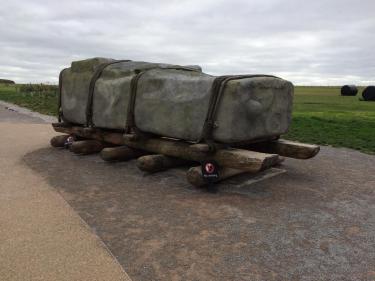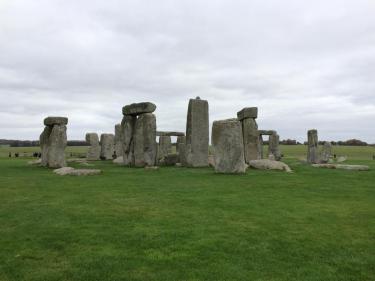One prominent travel guru who shall go unnamed—let’s call him “Nick Reves”—has recommended skipping Stonehenge. This advice is given, if I remember correctly, because you can’t walk among the giant stones anymore: you have to view them from a distance. To me this is akin to skipping the Eiffel Tower because you don’t get to climb it, or avoiding the Mona Lisa because you’ll only get to see it from behind a throng of Japanese tourists ignoring the no-photo signs.
Nick does get it right that Stonehenge is a bit out of the way. Damn those druids for not building it in the middle of London! It is, however, a comfortable distance from Salisbury. So if you’re considering a tour of Southern England that includes a stop in this splendid cathedral town (and you should), add a half-day to go out to Stonehenge.
Here’s how it works. You’ll drive to the Stonehenge site or you can arrange a day tour from your hotel or any number of tour operators in Salisbury (there are also tons of day tour options from London or Bath if you’re not going to Salisbury). You’ll park in a nice lot out in a field and emerge from your car thinking you’re in the wrong place: don’t worry when you don’t see big rocks. Walk to the visitor’s center and purchase your tickets (about £15 per adult, £2 more for audio guide, free if you’re an English Heritage or National Trust member1 though you do need to stand in the line for pass holders). If you’re visiting during high season (May to September) advanced online tickets are pretty much required (click here), though if you’re taking one of those tours your tickets are probably included (but ask to be sure).
Your tickets procured, proceed to the small museum. In a half hour to forty-five minutes, you’ll learn when and how Stonehenge was built, and by whom. You’ll learn Stonehenge was actually part of vast series of monuments and was the center of a much larger timber circle called (you guessed it) Woodhenge. Leaving the visitor center and museum, you can walk through a reconstructed village to see how the people who built Stonehenge likely lived. Pay particular attention to the exhibit of how they transported those massive stones using skids of rolling logs.

Display showing how Stonehenge’s stones were transported
Then move on to the bus stop (to the left of the door through which you exited the visitor’s center). Bus service runs every few minutes to take you from the visitor’s center to the actual site. Nick Reves hates buses, but the ride only takes a few minutes. From there you walk, and despite not being permitted to stroll among the ancient stones and chip off pieces to take home as souvenirs (as so many previous visitors did), you do get to walk all the way around the monument. It’s a nice stroll and the terrain varies to give you different perspectives and different angles. Some of those perspectives will surprisingly likely afford you photos without people in them. If you sprang for the audio guide, there are stops along the way to listen.


A couple of different (relatively low-crowd) perspectives on Stonehenge
Once you’ve seen enough, return to the bus drop-off point for a quick ride back to the visitor’s center. There you can warm up with a nice English tea and a scone.
Despite decades of archaeological research, we still don’t know exactly what Stonehenge was built for. Because it’s obvious the stones are aligned with the position of the sun during the spring and autumn equinoxes, many historians suggest Stonehenge was basically a calendar. But because thousands of tombs and cremated remains surround the site, it’s obvious Stonehenge was considered a sacred spot, or at least a spot of great cultural significance. A calendar, fundamentally a way to “predict” the future, perhaps was viewed as mystical and sacred.
Naturally, I have another theory, so hear me out.
People of the British Isles like their beer, this is no mystery. We know that beer-brewing technology predates Stonehenge by a couple of thousand years. By the time Stonehenge was constructed, beer in all its wondrous variety had been perfected. I suggest that Stonehenge was an early brewpub. The taller stones might have supported brew tuns and kettles, shorter stones may have served as tables for patrons, enabling an ingenious system of gravity-assisted pouring. The calendar function simply served to time the fermentation process.
The cynical among you might think I’m going to suggest the graves were for druids and their followers who drank themselves to death. You’d be silly to suggest such. The graves indeed indicate the sacred reverence of the site, just for a different reason.
It’s but a theory…though it’s mine.
Footnotes
1 – English Heritage and National Trust are two of England’s non-profit organizations for managing sites of historical, cultural, or natural significance. Each has their own list of sites, though Stonehenge is listed with both. A future blog might be in the works to describe the difference, but if you plan to visit 3 or more such sites listed with either, buying an annual membership is usually a money-saver, even if you are only visiting for a couple of weeks.






